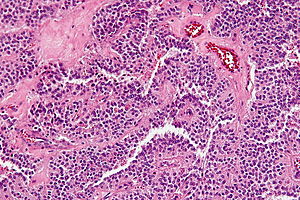Difference between revisions of "Solid pseudopapillary tumour"
Jump to navigation
Jump to search
(+infobox) |
|||
| Line 1: | Line 1: | ||
{{ Infobox diagnosis | |||
| Name = {{PAGENAME}} | |||
| Image = Solid_pseudopapillary_tumour_-_high_mag.jpg | |||
| Width = | |||
| Caption = Solid pseudopapillary tumour. [[H&E stain]]. | |||
| Synonyms = solid pseudopapillary neoplasm, solid and papillary epithelial neoplasm | |||
| Micro = solid sheets of cells - focally dyscohesive, eosinophilic cytoplasm (occasionally clear), focal eosinophilic (intracytoplasmic) globules, uniform nuclei with occasional nuclear grooves, +/-necrosis (creating spaces/cavities), +/-cholesterol clefts | |||
| Subtypes = | |||
| LMDDx = [[pancreatic pseudocyst]], cystadenoma, cystadenocarcinoma (see [[invasive ductal carcinoma of the pancreas]]), [[pancreatic neuroendocrine tumour]] | |||
| Stains = | |||
| IHC = PR +ve, CD10 +ve, beta-catenin +ve, chromogranin -ve, synaptophysin +ve (weak) | |||
| EM = | |||
| Molecular = | |||
| IF = | |||
| Gross = | |||
| Grossing = | |||
| Site = [[pancreas]] - usually tail | |||
| Assdx = | |||
| Syndromes = | |||
| Clinicalhx = typical young (20s or 30s), women (M:F = 1:9) | |||
| Signs = | |||
| Symptoms = | |||
| Prevalence = uncommon | |||
| Bloodwork = | |||
| Rads = | |||
| Endoscopy = | |||
| Prognosis = usu. benign | |||
| Other = | |||
| ClinDDx = | |||
| Tx = | |||
}} | |||
'''Solid pseudopapillary tumour''' is a pancreatic tumour that is usually found in the tail. | '''Solid pseudopapillary tumour''' is a pancreatic tumour that is usually found in the tail. | ||
It is also known as '''solid pseudopapillary neoplasm''' (abbreviation '''SPN''') and '''solid and papillary epithelial neoplasm''' (abbreviated '''SPEN''').<ref>URL: [http://brighamrad.harvard.edu/Cases/bwh/hcache/360/full.html http://brighamrad.harvard.edu/Cases/bwh/hcache/360/full.html]. Accessed on: 31 October 2011.</ref> | It is also known as '''solid pseudopapillary neoplasm''' (abbreviation '''SPN''') and '''solid and papillary epithelial neoplasm''' (abbreviated '''SPEN''').<ref>URL: [http://brighamrad.harvard.edu/Cases/bwh/hcache/360/full.html http://brighamrad.harvard.edu/Cases/bwh/hcache/360/full.html]. Accessed on: 31 October 2011.</ref> | ||
Revision as of 10:37, 5 March 2014
| Solid pseudopapillary tumour | |
|---|---|
| Diagnosis in short | |
 Solid pseudopapillary tumour. H&E stain. | |
|
| |
| Synonyms | solid pseudopapillary neoplasm, solid and papillary epithelial neoplasm |
|
| |
| LM | solid sheets of cells - focally dyscohesive, eosinophilic cytoplasm (occasionally clear), focal eosinophilic (intracytoplasmic) globules, uniform nuclei with occasional nuclear grooves, +/-necrosis (creating spaces/cavities), +/-cholesterol clefts |
| LM DDx | pancreatic pseudocyst, cystadenoma, cystadenocarcinoma (see invasive ductal carcinoma of the pancreas), pancreatic neuroendocrine tumour |
| IHC | PR +ve, CD10 +ve, beta-catenin +ve, chromogranin -ve, synaptophysin +ve (weak) |
| Site | pancreas - usually tail |
|
| |
| Clinical history | typical young (20s or 30s), women (M:F = 1:9) |
| Prevalence | uncommon |
| Prognosis | usu. benign |
Solid pseudopapillary tumour is a pancreatic tumour that is usually found in the tail.
It is also known as solid pseudopapillary neoplasm (abbreviation SPN) and solid and papillary epithelial neoplasm (abbreviated SPEN).[1]
General
- Obscure cell of origin.
- Considered low grade, i.e. prognosis is usually good.
Epidemiology
Features:[2]
- Usually females (M:F=1:9).
- Mean age of presentation third decade (20s).
Management
May be followed radiologically.
Microscopic
Features:[3]
- Solid sheets of cells, focally dyscohesive.
- Eosinophilic cytoplasm.
- Occasionally clear cytoplasm.[4]
- Focal eosinophilic (intracytoplasmic) globules - key feature.
- Uniform nuclei with occasional nuclear grooves.
- +/-Necrosis - creating spaces/cavities.
- +/-Cholesterol clefts.[5]
DDx:
- Pancreatic pseudocyst.
- Cystadenoma.
- Cystadenocarcinoma - see invasive ductal carcinoma of the pancreas.
- Pancreatic neuroendocrine tumour - may have cytoplasmic vacuolation, hyaline globules.[4]
Images
www:
IHC
Features:[4]
- Beta-catenin +ve ~100% (cytoplasmic & nuclear).
- E-cadherin +ve ~100% (cytoplasmic), -ve (membrane); antibody dependent.
- CD10 +ve ~ 80% (cytoplasmic + dot-like) key.
- Synaptophysin +ve (weak cytoplasmic) ~70%.
- Progesterone receptor +ve (nuclear) key.
Others:
- CD56 +ve.
- Chromogranin -ve.
Memory device PCB: PR (nuclear), CD10 (cytoplasmic), beta-catenin (cytoplasmic & nuclear).
See also
References
- ↑ URL: http://brighamrad.harvard.edu/Cases/bwh/hcache/360/full.html. Accessed on: 31 October 2011.
- ↑ Iacobuzio-Donahue, Christine A.; Montgomery, Elizabeth A. (2005). Gastrointestinal and Liver Pathology: A Volume in the Foundations in Diagnostic Pathology Series (1st ed.). Churchill Livingstone. pp. 493. ISBN 978-0443066573.
- ↑ Iacobuzio-Donahue, Christine A.; Montgomery, Elizabeth A. (2005). Gastrointestinal and Liver Pathology: A Volume in the Foundations in Diagnostic Pathology Series (1st ed.). Churchill Livingstone. pp. 493-5. ISBN 978-0443066573.
- ↑ 4.0 4.1 4.2 Serra S, Chetty R (November 2008). "Revision 2: an immunohistochemical approach and evaluation of solid pseudopapillary tumour of the pancreas". J. Clin. Pathol. 61 (11): 1153–9. doi:10.1136/jcp.2008.057828. PMID 18708424. http://jcp.bmj.com/content/61/11/1153.
- ↑ Abad Licham, M.; Sanchez Lihon, J.; Celis Zapata, J.. "[Pseudopapillary solid tumor of pancreas in the INEN].". Rev Gastroenterol Peru 28 (4): 356-61. PMID 19156179.




